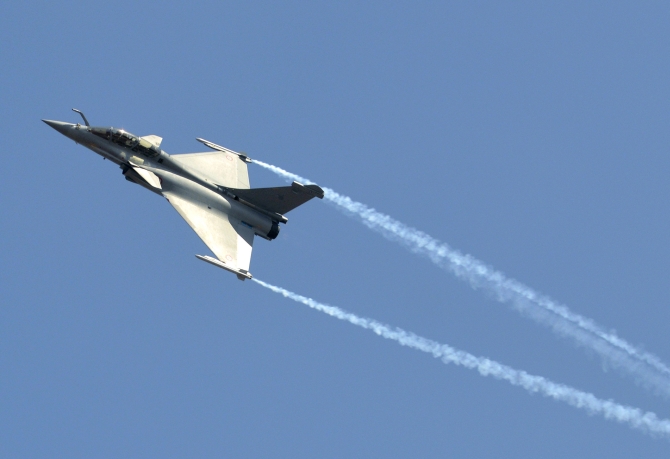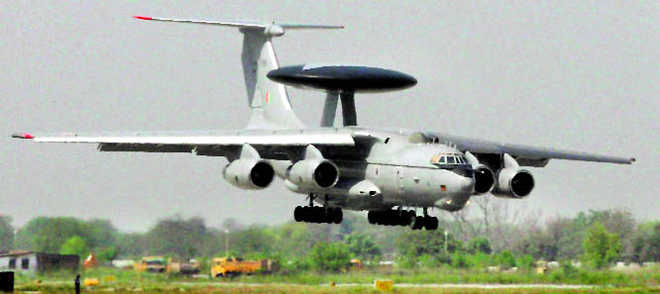IMAGE: A Dassault Rafale combat aircraft seen during Aero India 2013 at the Yelahanka air force station on the outskirts of Bengaluru. Photograph: Reuters
‘Let us remember that Make in India for defence must not be our goal.’
‘The goal is to have a strong military to help the nation protect its identity and assert its will,’ says Air Marshal P V Athawale (retd).
Years ago, a Swamiji was invited by the College of Defence Management as a part of a series of guest lectures. What stayed with me was his analogy for human behaviour. He spoke about the two distinctive human behavioural patterns — the ‘dog pattern’ and the ‘cat pattern.’
A dog and a cat lived in each other’s neighbourhood. Both were happy in their respective lives. The dog said, ‘I am happy; my master looks after me very well — he is God.’ The cat was different. He said, ‘I am happy; my master looks after me very well because I am God.’
Ever since, I have looked at different situations of conflict with Swamji’s wisdom. Everything falls into place once we appreciate the patterns of human behaviour where some people or organisations expect others to submit to them. I call it the ‘I am God’ syndrome.
When interacting elements begin to believe that ‘I am God,’ despite each one meaning well, the result is a lack of synergy and non-accomplishment. This is what happens between the players that aspire to build indigenous capability for the Indian armed forces.
People often cite the development of space capability and the accomplishments in atomic energy and exclaim, ‘If they can do this, why not defence!’ They overlook the unity of direction in those domains — the designer, developer, user and maintainer being under the control of a single agency.
The military capability of a nation rests on a triangular base. The three pillars are:
- The armed forces on the basis of assets and training/preparation;
- Research and development capability;
- Manufacturing/industrial capacity.
The military could also be classified into three distinct classes on the basis of its influence: Local, regional and global. However proficient a fighting force be, its reach will be localised if the nation’s R&D and industrial capability are insignificant.
For a nation to aspire to enhance its military influence to the regional level, it has to progressively improve its industrial capability.
Finally, any military can have global influence only if the nation’s R&D and industry are dominant players with a cutting edge over adversaries. This gives its military the first use of best weapon systems to develop operational concepts and tactics ahead of other nations.
Let us remember that Make in India for defence must not be our goal. The goal is to have a strong military to help the nation protect its identity and assert its will. Enhanced indigenous industrial capability is a prerequisite for the nation’s military to be reliable and effective in times of crisis.
Therefore, indigenous design/development and manufacturing capability are necessary conditions to achieve the goal of maintaining a powerful military force. This simply means that Make in India cannot be forced upon the military without ensuring that it meets the requirements.
In a recent discussion on the subject at IIT-Roorkee, the defence minister pointed out the prerequisite by saying that ‘the needs of the armed forces cannot be overlooked.’
Each of the three pillars or components of military capability (Armed forces, R&D, and industrial capacity) are often measured for performance in isolation. Consequently, each one strives to maximise its performance in seclusion. It is convenient to work independently towards a localised objective.
The industry (mainly defence PSUs) have made profits through licensed manufacturing, while progressively reducing the design & development effort — the local measures of production and profits have been well satisfied.
The Defence Research and Development Organisation, satisfied in accomplishing programmes which permit autonomy in execution, have given little of significance to military aviation’s requirements. Both DRDO and defence PSUs view the armed forces’ penchant for foreign systems as a problem.
The armed forces, who carry the ultimate responsibility, justify foreign purchases because of the lack of availability of indigenously developed state-of-the-art weapon systems.
Strategic thinkers often wonder why we cannot produce indigenous designs today, when we (Hindustan Aeronautics Limited) had produced an indigenously designed and developed multi-role fighter aircraft (HF-24 Marut) in the early 1960s.
Back then, DRDO hadn’t quite grown and HAL’s top management was deputed from the air force. These situations are not relevant to the size of these organisations and the expected performance from defence R&D and industry today. The fact is that the unified direction and control of those times was vital in creating the HF-24 Marut.
Both DRDO and HAL are now big empires; Gods in their own right, who desire submission by their clients and acceptance of their products as a mark of appreciation for their hard work. It is not uncommon to hear expressions like ‘The air force would keep asking for more, but had to be directed to accept!’
On its part, the air force is not happy to compromise specs — there is a limit to which the genius of our pilots can offset our aircraft deficiencies compared to adversaries.
When the old specs are nearly met a decade later, the world has moved on and those specs now fall short of the air force’s current expectations. And the process goes on.
As a solution, the air force looks for more control and makes futile attempts to make the impossible happen — have an air force pilot as the chairman of HAL.
Every player in the arena has noble intentions towards making the nation stronger. However, each one’s perception of the requirements is different. These perceptions differ because they are based on inappropriate assumptions to satisfy local measures.
The result is that we have three Gods to be brought together (in addition to the much needed private industry).
The solution is not ‘win-win’ — no one should be forced into compromises. Industry shouldn’t be made to wait endlessly for products to be put to use. There is no short cut to development of hi-tech systems.
Our own armed forces have to use indigenous systems at intermediate stages of technological development for products to mature and be counted among the best in the world. At the same time, the armed forces need for state-of-the-art should be acknowledged before jeopardising acquisitions in view of unrealistic assurances of indigenous development timeframes.
The ‘I am God’ syndrome won’t permit us to Make in India until all agencies come together to find this win-win solution.
The defence minister may consider the appointment of a coordination group consisting of those with techno-military acumen to facilitate synergy to advise him directly without the bureaucracy stepping in as another super God.
Air Marshal P V Athawale (retd) is the former Air Officer Commanding-in-Chief, Maintenance Command, Indian Air Force.



































































